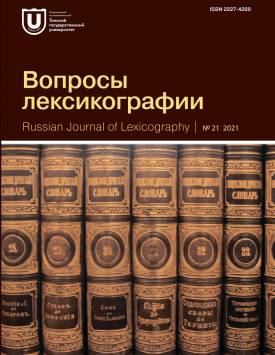A New Handwritten Dictionary of the Komi-Zyryan Language in the History of Komi Lexicography
The article presents an analysis of the lexical composition of the newly discovered Zyryan-Russian dictionary of the 17th century and clarifies its place in the history of Komi lexicography. The article solves the problems of classification of lexicographic monuments and systematization of approaches to their description, and reveals gaps in research that has not been conducted since the mid-20th century. The currently known lexicographic monuments of the Komi language are limited to the dictionary materials of D.G. Messerschmidt, F.I. Stralenberg, G.F. Miller, P.S. Pallas and I.I. Lepekhin; the materials were collected during their expeditions in the 1720s-1770s. Unlike the church monuments of the Old Komi language of the 14th-17th and 18th centuries, the materials have not yet received a thorough archaeographic description, textual analysis and cultural and historical interpretation. The new Zyryan-Russian dictionary, discovered as part of the manuscript collection of the monk Prokhor Kolomnyatin and accurately dated (1668), is the earliest monument in the history of Komi lexicography today. The dictionary is interesting because it belongs to the period almost undocumented by written evidence and differs from all existing monuments in its dialect basis. The article describes the structure of the dictionary, thoroughly analyzes the lexical composition and presents most of its content, and reveals parallels with the dictionary materials of other monuments. The Russian-Komi dictionary-phrasebook that 1.1. Lepekhin found and published in his Diary Notes is considered in more detail. Later V.I. Lytkin reprinted and deciphered the phrasebook, as well as made commentaries on it in his Old Permic Language (1952); thus, it became an auxiliary material for the reconstruction of the Old Komi language of the 14th-17th centuries. The dictionary dates back to the 18th century, although it has not been subjected to serious cultural-historical and chronological attribution. The newly discovered monument, unlike Lepekhin’s dictionary created by the type of translated old Russian dictionaries-phrasebooks based on the Russian questionnaire, reflects the live Komi-Zyryan language of the second half of the 17th century. It does not contain typical phrases, phrases from dialogues and connected texts that are typical of translated phrasebooks. There is only a certain tendency towards a thematic presentation of the material, although not always consistent. Like the dictionary materials contained in the draft papers of Russian and foreign travellers of the 18th century, the vocabulary of the new dictionary was written by the author of the collection directly from the words of a native speaker (or native speakers) of the Komi language in order to fix it and, apparently, was not intended for communicative use. Unlike the existing dictionary materials, which often contain short lists of Komi numerals, the new dictionary contains a consistent detailed money vocabulary list, from “denga” to “thousand rubles”. Numerical values are given in the Cyrillic numeral system using letters, which is undoubtedly of interest for ethnohistorical research and Russian paleography.
Keywords
historical lexicography, written monuments, handwritten dictionary-phrasebook, Komi-Zyryan language, vocabularyAuthors
| Name | Organization | |
| Fedyuneva Galina V. | Komi Science Centre of the Ural Branch of the Russian Academy of Sciences | fedyuneva@yandex.ru |
References

A New Handwritten Dictionary of the Komi-Zyryan Language in the History of Komi Lexicography | Voprosy leksikografii – Russian Journal of Lexicography. 2021. № 21. DOI: 10.17223/22274200/21/4
